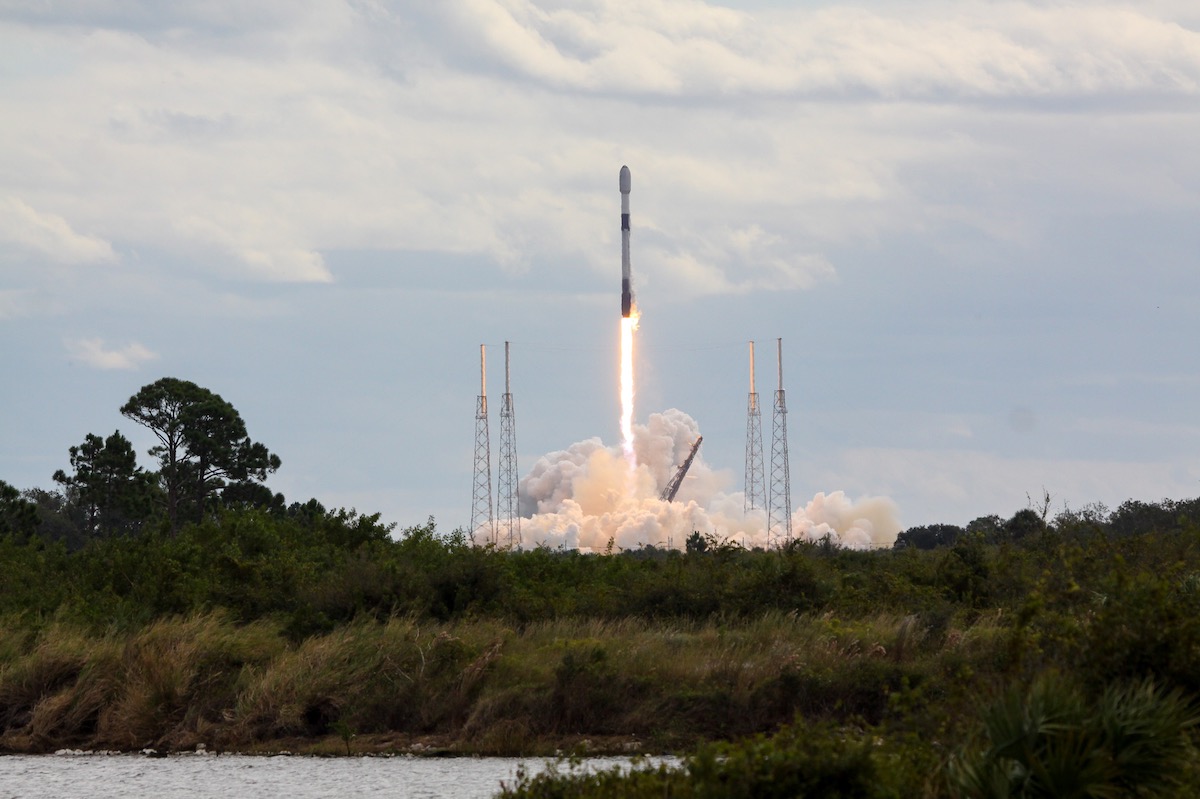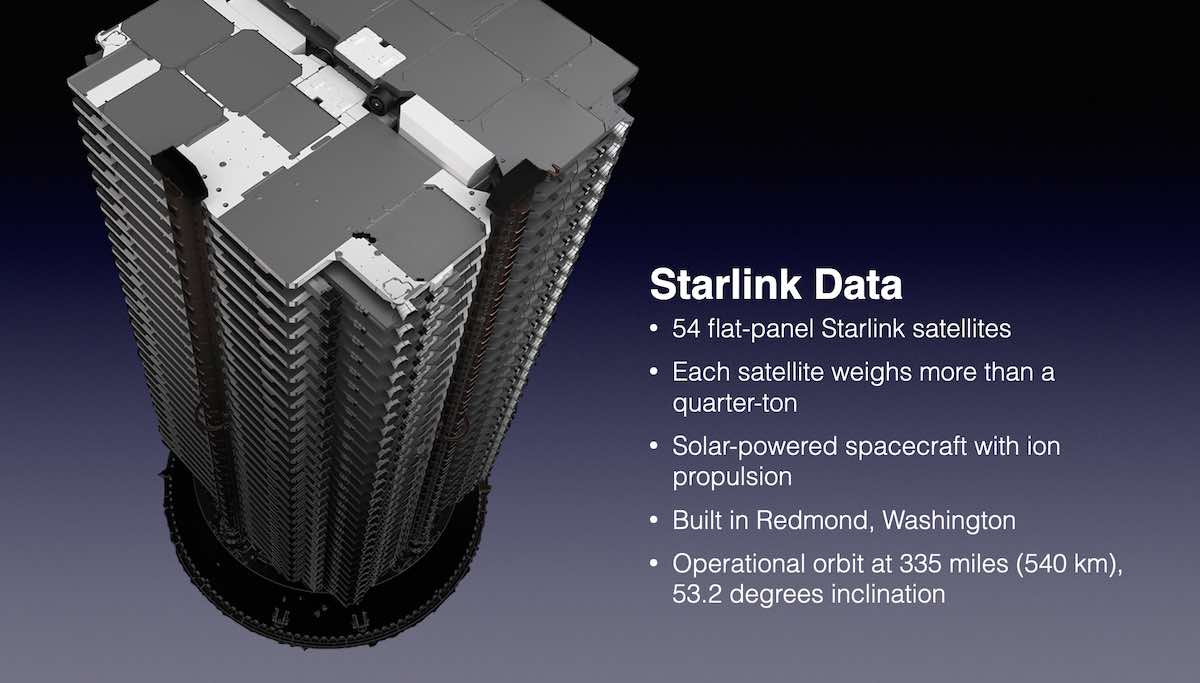Live coverage of the countdown and launch of a SpaceX Falcon 9 rocket from Space Launch Complex 40 at Cape Canaveral Space Force Station in Florida. The Starlink 4-36 mission launched SpaceX’s next batch of 54 Starlink broadband satellites. Follow us on Twitter.
SFN Live
Fifty-four Starlink internet satellites fastened to a Falcon 9 rocket blasted off Thursday from Cape Canaveral, continuing SpaceX’s deployments for a broadband network reaching into an ever-expanding market linking rural households, ships, commercial airplanes, and Ukrainian military forces in their fight against Russia.
The 54 satellites launched at 10:50:40 a.m. EDT (1450:40 GMT) Thursday from pad 40 at Cape Canaveral Space Force Station.
The 229-foot-tall (70-meter) Falcon 9 rocket arced northeast from Florida’s Space Coast, aiming for a low Earth orbit inclined 53.2 degrees to the equator. The rocket’s upper stage released the 54 flat-packed Starlink satellites about 15 minutes into the mission.
The satellites on-board the Falcon 9 will add to SpaceX’s consumer-grade, high-speed, low-latency internet network. Subscribers can currently connect to the Starlink network in more than 40 countries and territories, and Japan recently became the first Asian nation to receive Starlink service.

Alongside previous offerings aimed at homes and businesses, RVs, and boats and ships, SpaceX on Tuesday announced Starlink service for aircraft. “With Starlink, passengers will be able to access high-speed, low-latency internet from the moment they walk on their plane,” SpaceX tweeted.
The company said airlines can outfit their planes with Starlink receives for a “one-time hardware cost” of $150,000, presumably per aircraft, with deliveries starting in 2023. The service fee will range between $12,500 to $25,000 per month, SpaceX said.
For comparison, SpaceX charges $110 per month for Starlink’s basic consumer-grade broadband service, with a one-time hardware cost of $599.
While most customers have to pay to connect to the network, SpaceX has provided Starlink ground terminals and internet service for free to Ukraine’s government and military since the days after the start of Russia’s invasion of the country in February.
CNN reported this week that SpaceX sent a letter to the Pentagon last month saying it can no longer continue funding the Starlink service in Ukraine as it has since February. Ukraine’s military has relied on the network to maintain communications as terrestrial cell phone and internet networks were destroyed or disrupted by Russian attacks.
Elon Musk, SpaceX’s founder and CEO, tweeted Oct. 7 that providing the Starlink service in Ukraine has cost SpaceX $80 million to date, and that figure will exceed $100 million by the end of the year. Around 25,000 Starlink user terminals have been sent to Ukraine so far, with roughly 11,000 of them paid for by countries, organizations, and donors, but not the U.S. Defense Department, according to Musk.
In addition to terminals, we have to create, launch, maintain & replenish satellites & ground stations & pay telcos for access to Internet via gateways.
We’ve also had to defend against cyberattacks & jamming, which are getting harder.
Burn is approaching ~$20M/month.
— Elon Musk (@elonmusk) October 14, 2022
SpaceX is not asking to recoup past expenses, but also cannot fund the existing system indefinitely *and* send several thousand more terminals that have data usage up to 100X greater than typical households. This is unreasonable.
— Elon Musk (@elonmusk) October 14, 2022
SpaceX was widely praised when it began donating Starlink internet terminals to Ukraine in February, but Musk’s comments encountered a backlash on social media. The world’s richest man appeared to change his mind earlier this week, tweeting that SpaceX will continue funding the Starlink service in Ukraine.
SpaceX is losing about $20 million per month “due to unpaid service and costs related to enhanced security measures for cyberwar defense, but we’ll keep going it (sigh),” Musk tweeted Tuesday.
Politico reported Monday that the Pentagon is considering paying for the Starlink satellite network in Ukraine, citing two unnamed U.S. officials involved in the deliberations.
The hell with it … even though Starlink is still losing money & other companies are getting billions of taxpayer $, we’ll just keep funding Ukraine govt for free
— Elon Musk (@elonmusk) October 15, 2022
Musk said the Starlink program is not yet a moneymaker for SpaceX.
“Also, Starlink is still losing money!” Musk tweeted. “It is insanely difficult for a LEO communications constellation to avoid bankruptcy – that was the fate of every company that tried this before.”
SpaceX is developing an upgraded, much larger Starlink satellite design sized to launch on the company’s huge next-generation Starship rocket. But the Starship has not yet attempted a launch into low Earth orbit, and Musk said delays in developing and testing the new rocket could force SpaceX to start launching a smaller version of the new Starlink satellite design on Falcon 9 rockets.
SpaceX is more than halfway complete with deploying the initial fleet of 4,400 Starlink internet satellites. The company has approval from the Federal Communications Commission to eventually launch and operate up to 12,000 Starlink spacecraft, and SpaceX has signaled it could aim to fly as many as 42,000 Starlink satellites in orbit.
The Starlink network was conceived as a venture to help draw in revenue to fund SpaceX’s ambition to build a base on Mars. The Starship rocket itself, designed to be fully reusable with relatively low operating costs, is central to Musk’s Mars dream.
After Thursday’s mission, SpaceX has 3,505 Starlink satellites into orbit, including prototypes and failed spacecraft. The company currently has more than 3,100 functioning Starlink satellites in space, with about 2,700 operational and another 400 moving into their operational orbits, according to a tabulation by Jonathan McDowell, an expert tracker of spaceflight activity and an astronomer at the Harvard-Smithsonian Center for Astrophysics.
The launch Thursday, designated Starlink 4-36, was SpaceX’s 48th launch so far in 2022. SpaceX plans to complete more than 60 missions this year, an average of about one launch every six days.
The higher launch rate has been aided by shorter turnarounds between missions at launch pads in Florida and California, and SpaceX’s reuse of Falcon 9 boosters and payload fairings. Launches carrying satellites for SpaceX’s own Starlink internet network, like the mission Thursday, have accounted for about two-thirds of the company’s Falcon 9 flights so far this year.
The Falcon 9 booster used on Thursday’s mission is numbered B1062 in SpaceX’s inventory of reusable rockets. The booster launched for the first time on Nov. 5, 2020, with a U.S. military GPS navigation satellite, and launched another GPS mission on June 17, 2021. It has launched two commercial astronaut missions — Inspiration4 and Axiom-1 — along with the Nilesat 301 communications satellite for Egypt, and four previous Starlink missions.
The Starlink 4-36 mission was the 10th flight of B1062.

Stationed inside a launch control center just south of Cape Canaveral Space Force Station for Thursday’s countdown, SpaceX’s launch team began loading super-chilled, densified kerosene and liquid oxygen propellants into the Falcon 9 vehicle at T-minus 35 minutes.
Helium pressurant also flowed into the rocket in the last half-hour of the countdown. In the final seven minutes before liftoff, the Falcon 9’s Merlin main engines were thermally conditioned for flight through a procedure known as “chilldown.” The Falcon 9’s guidance and range safety systems were also configured for launch.
After liftoff, the Falcon 9 rocket vectored its 1.7 million pounds of thrust — produced by nine Merlin engines — to steer northeast over the Atlantic Ocean.
The rocket exceeded the speed of sound in about one minute, then shut down its nine main engines two-and-a-half minutes after liftoff. The booster stage released from the Falcon 9’s upper stage, then fired pulses from cold gas control thrusters and extended titanium grid fins to help steer the vehicle back into the atmosphere.
Two braking burns slowed the rocket for landing on the drone ship “A Shortfall Of Gravitas” around 400 miles (650 kilometers) downrange approximately nine minutes after liftoff.
The Falcon 9’s reusable payload fairing jettisoned during the second stage burn. A recovery ship was also on station in the Atlantic to retrieve the two halves of the nose cone after they splash down under parachutes.
Landing of the first stage on Thursday’s mission occurred moments after the Falcon 9’s second stage engine cuts off to deliver the Starlink satellites into orbit. Separation of the 54 Starlink spacecraft, built by SpaceX in Redmond, Washington, from the Falcon 9 rocket was confirmed at T+plus 15 minutes, 23 seconds.
Retention rods released from the Starlink payload stack, allowing the flat-packed satellites to fly free from the Falcon 9’s upper stage in orbit. The 54 spacecraft will unfurl solar arrays and run through automated activation steps, then use krypton-fueled ion engines to maneuver into their operational orbit.
The Falcon 9’s guidance computer aimed deploy the satellites into an elliptical orbit at an inclination of 53.2 degrees to the equator. The satellites will use on-board propulsion to do the rest of the work to reach a circular orbit 335 miles (540 kilometers) above Earth.
The Starlink satellites will fly in one of five orbital “shells” at different inclinations for SpaceX’s global internet network. After reaching their operational orbit, the satellites will enter commercial service and begin beaming broadband signals to consumers, who can purchase Starlink service and connect to the network with a SpaceX-supplied ground terminal.
ROCKET: Falcon 9 (B1062.10)
PAYLOAD: 54 Starlink satellites (Starlink 4-36)
LAUNCH SITE: SLC-40, Cape Canaveral Space Force Station, Florida
LAUNCH DATE: Oct. 20, 2022
LAUNCH TIME: 10:50:40 a.m. EDT (1450:40 GMT)
WEATHER FORECAST: Greater than 90% chance of acceptable weather; Low-moderate risk of upper level winds; Low risk of unfavorable conditions for booster recovery
BOOSTER RECOVERY: “A Shortfall Of Gravitas” drone ship east of Charleston, South Carolina
LAUNCH AZIMUTH: Northeast
TARGET ORBIT: 144 miles by 209 miles (232 kilometers by 336 kilometers), 53.2 degrees inclination
LAUNCH TIMELINE:
- T+00:00: Liftoff
- T+01:12: Maximum aerodynamic pressure (Max-Q)
- T+02:27: First stage main engine cutoff (MECO)
- T+02:31: Stage separation
- T+02:38: Second stage engine ignition
- T+02:42: Fairing jettison
- T+06:50: First stage entry burn ignition (three engines)
- T+07:09: First stage entry burn cutoff
- T+08:29: First stage landing burn ignition (one engine)
- T+08:42: Second stage engine cutoff (SECO 1)
- T+08:49: First stage landing
- T+15:23: Starlink satellite separation
MISSION STATS:
- 182nd launch of a Falcon 9 rocket since 2010
- 190th launch of Falcon rocket family since 2006
- 10th launch of Falcon 9 booster B1072
- 156th Falcon 9 launch from Florida’s Space Coast
- 101st Falcon 9 launch from pad 40
- 156th launch overall from pad 40
- 123rd flight of a reused Falcon 9 booster
- 64th dedicated Falcon 9 launch with Starlink satellites
- 48th Falcon 9 launch of 2022
- 48th launch by SpaceX in 2022
- 46th orbital launch attempt based out of Cape Canaveral in 2022
Email the author.
Follow Stephen Clark on Twitter: @StephenClark1.
